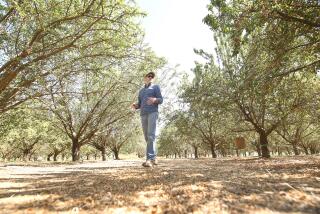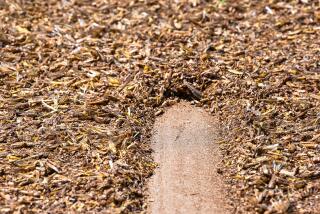Bugs Do ‘God-Awful’ Damage to the Trees
A critter the size of a pinhead is wreaking havoc among Orange County’s stately eucalyptus groves, leaving landscapers, homeowners and agriculture officials scurrying for a weapon against the stubborn invaders.
“I’ve never seen anything like it,” said Tony Plante, public works superintendent for Lake Forest, where the infestation by an insect called the redgum lerp psyllid is among the worst in the county. “And there’s really not much we can do--our hands are tied.”
Biologists said they have no way to control the psyllids, and though research is underway, a solution could take years. The scourge is the latest in a series of threats--from other insects to chain saws--to the trees, which came to California from Australia more than a century ago and thrived unmolested until recently.
First spotted last year in El Monte, the Australian bugs have spread as far east as Phoenix, north to Sacramento and south to San Diego.
They’ve been found throughout Orange County, leaving a telltale sticky substance called honeydew on yards, patio furniture and cars, said Brian Danker, who is monitoring the problem for the Orange County agricultural commissioner’s office.
The bugs do not kill eucalyptus trees but leave them barren of leaves, weakened and susceptible to disease.
They attack mostly the redolent leaves of red gum eucalyptus trees, which are widespread in California. The bugs deplete moisture from the leaves and cover them with honeydew, then leave their young behind protected in tiny white cones called lerps.
Because the honeydew also blocks photosynthesis, the leaves are deprived of nutrients and eventually fall off.
Rosser Garrison, entomologist for the Los Angeles County agricultural commissioner’s office, which first identified the pests, said the trees are effectively being bled.
“I’ve seen rows of eucalyptus trees that have been infested and it looks like a fire just went through them,” he said. “They look hollow.”
What makes this pest more difficult to control than others is the lerps, the tiny white cone-like shelters that protect the larvae, said Donald Dahlsten, a UC Berkeley entomologist. The shells, about an eighth of an inch long, are tough for other insects to penetrate and partially guard against insecticides.
The bugs also are reproducing at a faster pace than they could be eaten by predators, such as ladybugs, Dahlsten said.
“It’s bad. It’s real bad,” said Dahlsten, who soon will travel Down Under to look for a natural enemy to bring back to California. “We have all kinds of insects introduced into this country every year, and every once in a while, we get one that really gets established. . . . This is one of them.”
Lake Forest resident Laurie Smith uses a leaf blower twice a day to clear her driveway and backyard as a result of the psyllid infestation of more than 100 eucalyptus trees on her property. Within a week, she collected seven large trash bags of dead leaves. In a desperate attempt to save the lower branches, she sprays them with a water hose a few times a day, along with patio furniture, which is covered with the sticky clear honeydew.
“I can’t enjoy my backyard anymore. I can’t just sit outside and read the paper. I can’t let my dog out without clearing a path first, because all that stuff will be tracked into the house,” said Smith, a consultant who bought the house mainly because of the eucalyptus groves. “It has been just god-awful.”
Smith first noticed the psyllids about five weeks ago. Her son had washed her car and parked it in the driveway one night. By the next morning, it was covered in honeydew. Smith went to her homeowners association, the city’s Public Works Department and then the county, but no one could help her.
“Everywhere we go, all we get is, ‘There’s nothing we can do,’ ” Smith said. “Meanwhile, we’re watching our forest disintegrate.”
Eucalyptus trees are native to Australia and were introduced to California in 1859. Soon they were being used as firewood and windbreaks for citrus groves.
While the tree has become a symbol of the California landscape, it also has met the ire of some homeowners. They contend that the easily felled branches are dangerous, and the trees flame up like torches and block prime vistas.
In March, the state accused four men of masquerading as Caltrans workers and illegally chopping down more than 50 eucalyptus trees blocking ocean views in San Clemente, according to a civil lawsuit.
The loathing some people have for the eucalyptus trees has led some scientists and others to jokingly speculate that the psyllids have been deliberately imported.
In reality, entomologists say the possibility of tree terrorism is highly unlikely. Instead they point to the increase in cargo and travel to and from Australia.
Eucalyptus trees have survived the first 130 years pretty much pest-free but have been bombarded by 12 parasitic insects since 1983. Among the worst was the longhorned borer beetle and its cousin, which can kill the trees. However, they were not as widespread and are easier to control, Garrison said.
Then, earlier this year, authorities found another insect, the citrus gum gall wasp. Discovered in San Pedro, the insect lays eggs inside eucalyptus leaves and feeds on the plant tissue.
“Everyone is scratching their heads and saying, ‘What the heck is going on?’ ” said Doug Yanega, a UC Riverside entomologist. “Why are we getting these things one after another?”
(BEGIN TEXT OF INFOBOX / INFOGRAPHIC)
Infesting Eucalyptus
The redgum lerp psyllid, native to Australia, has infested trees throughout Orange County and the rest of the state.
* Young psyllids stay in round, white mounds called lerps.
* Heavy infestations can cause severe leaf drop.
* Psyllids shed lerps as they mature.
Source: Rosser W. Garrison
More to Read
Sign up for Essential California
The most important California stories and recommendations in your inbox every morning.
You may occasionally receive promotional content from the Los Angeles Times.









